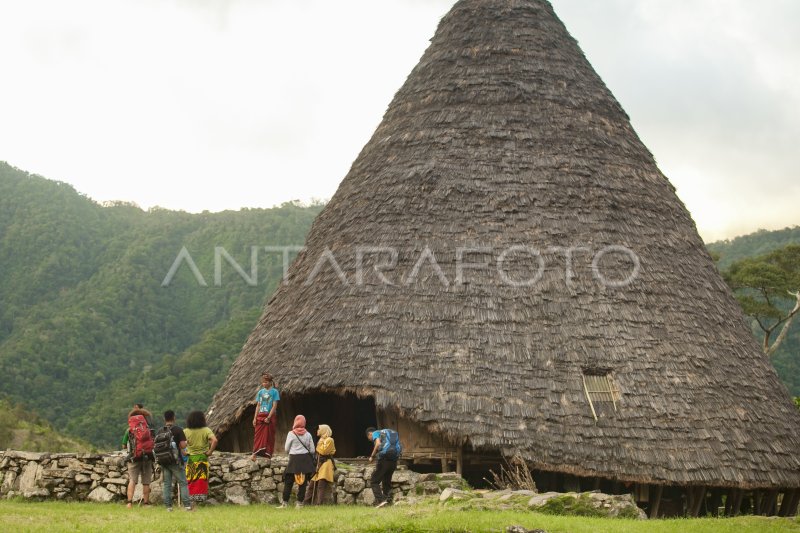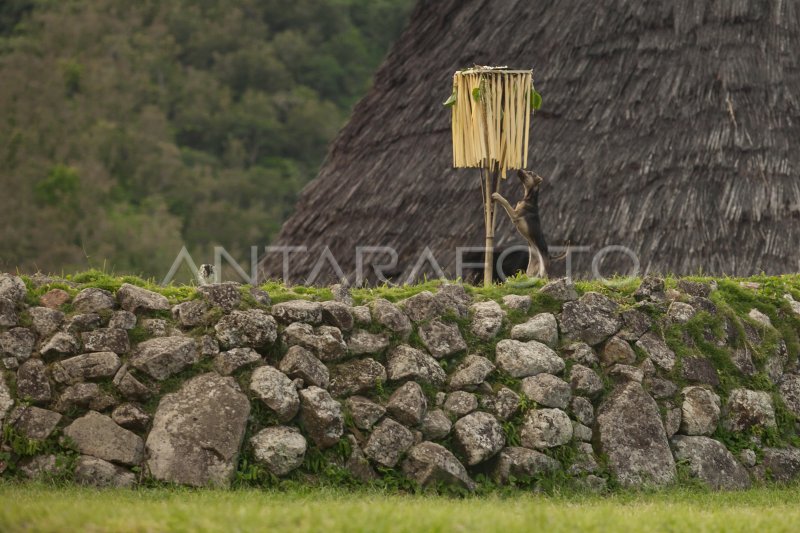Visit Manggarai Regency, NTT, in addition to see Komodo's ancient animal habitat, it is not complete if it has not climbed the foot in Waerebo village, a custom village that stores long cultural history, located above 1200 Mdpl height.
The location in the valley sandwiched several backs makes the small village to be beautiful and charming. But to reach the village is not easy, tourists should climb the forest for up to 7 km for approximately 4 hours.
After the long journey of tourists will arrive at the three post called Ponto Nao, from this post began to look from the distance of the custom house building from the cone-shaped rumbia winding wood called Mbaru Niang. Tourists are obliged to swell as a sign that there will be guests who come.

Edelweisss (Anaphalis javanica) is visible in the two climbing lines towards Waerebo village.

Wisatawan sounds the dexterity in the post three as a sign that there will be guests coming to Waerebo village.
The custom house consists of seven buildings that are divided into two parts, namely the main house or a gendang house that serves as a custom musyawarah place, and six companion houses or Mbaru Gena, consists of Mandok, Jintam, Ndorom, Jekong, and Mbaru Gena Maro who is home to guests who visit.
Tourists or guests who visit are welcomed Pa'u Wae Lu'u custom ceremony aimed at requesting permits and protection to the ancestors against guests to leave the village. According to the Head of customs, their ancestors originated from Minangkabau, West Sumatra, which is to visit Waerebo valley, which is currently the 19th generation.
In the village it can be overnight at Rp325,000 per night, the money is used for dining purposes, the maintenance of village infrastructure, fuel generator set and water source.

Wisatawan arrived at Waerebo indigenous village to follow the custom ceremony.

Tetua Adat Waerebo conducts custom rituals welcome the reimbursement of the rainy season called the traditional ceremony of Kasawiang.
The population also develops coffee commodities as its livelihood, Arabica type coffee is a superior product because of its distinctive aroma and taste, tourists can taste Waerebo’s signature coffee by buying directly from residents at Rp80.000 – Rp200.000 per kilogram.
It is Waerebo, the village with its fascinating natural beauty as well as the hospitality of its population, which will always uphold the cultural value of their ancestors under the findings, local cultural wisdom will continue to be preserved in every generation.
Then in 2012 UNESCO established a village with the indigenous building as a world cultural heritage because of its success of “mengayomi conservation issues in a broad coverage in local governance”.

Tetua Adat Waerebo conducts custom rituals welcome the reimbursement of the rainy season called the traditional ceremony of Kasawiang.

See the dog is above the purified altar called Compang.
Photo and Text: Muhammad Adimaja

The number of women of indigenous villages Waerebo cooking for tourist guests who come to the village.

Senja in the village of Adat Waerebo.

Warga serves coffee that is the result of community plantations in Waerebo village.

The Old Man of the Waerebo Alexander Ngarus poses with the background of the main house called Rumah Gendang.

The people bocah together his parents are in his home called Mbaru Gena.

The village houses of the indigenous Waerebo called Mbaru Niang, Rumah Gendang or the main house (right) and three Mbaru Gena or companion house.

The building of indigenous village houses Waerebo called Mbaru Niang.